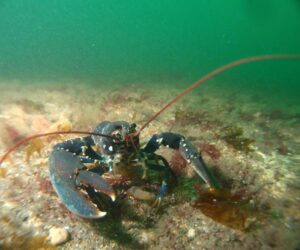The European lobster is an invertebrate marine creature with a rigid, segmented body covering called an exoskeleton. It has five pairs of legs, one pair of which is modified into claws for cutting and crushing. Lobsters are dark in colour, either bluish-green or greenish-brown/black, to blend in with the ocean floor where they live.
Behaviour
Lobsters are scavengers meaning they feed on whatever they can find on the ocean floor. This includes dead fish, crabs, and other small animals. They use their claws to tear apart their prey. Lobsters are mostly nocturnal and have chemoreceptors on their antennae to help them find food in dark, murky water.
The exoskeleton does not grow. As the shell becomes light, the lobster sheds it. A new exoskeleton forms under the existing shell and all the nutrients are absorbed back into the body.
Lobsters are unisexual, i.e. there are males and females. Lobsters only mate after females moult their exoskeleton. The male pierces the abdomen of the female and deposits sperm. When the female considers the time is right, she releases eggs to be fertilized by the sperm stored within her. The female then fixes the eggs, (around 5000 to 10000) under her tail, where they remain for ten to fifteen months. During this time, the female lobsters are commonly called berried, because the eggs look like small berries. Once hatched, baby lobsters moult four times before they start to show any resemblance to adults.
Size
- Average carapace length: 20-25 cm
- Average lifespan: 45 to 50 years
Status
Increased fishing pressure, habitat destruction, pollution and limited controls on the fishery are putting stress on lobster populations in Scotland. Conservation methods, such as the lobster hatchery in the Firth of Forth, are helping to maintain healthy populations.
Distribution
The European lobster lives all around the coast of Scotland, typically on hard ground in relatively shallow waters.
When to see
January to December
Facts
- The earliest records of lobster fishing in Scotland date back to the 12th century.
- Lobsters, like snails and spiders, have blue blood due to the presence of hemocyanin, which contains copper.

